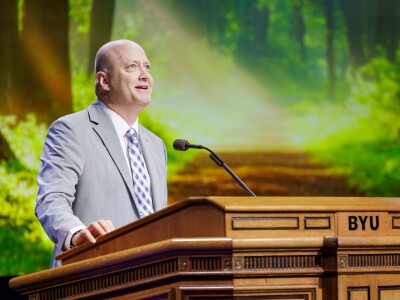In Tuesday’s forum, Harvard law professor Ruth Okediji explored a paradox: the stronger a nation’s commitment to religious freedom, the less a faithful presence Christians feel they can have in secular society.
While noting that the private sphere to which religious practice has been relegated is “the shield that allows the most sacred of worship,” Okediji observed that the private sphere has also unfortunately become “the instrument that endangers the rights of the fully integrated person to participate in society” while expressing faith.

She traced the history of religious freedom as a legal concept from its origin in the U.S. Constitution to modern-day interpretations. Originally religious freedom was designed to protect individuals’ religious practice from state power. Though a protected individual right, religion remained a source of nourishment for public wellbeing and was seen as a means of promoting justice and human dignity.
During the nineteenth century, however, “private realm” matters came to be seen as both untouchable by government and unwelcome in public discourse.
The private realm “became a zone in which private market power replaced the state’s duty to nurture wellbeing, virtue and justice,” Okediji said. In this way, now “the currency of religious freedom reinforces the idea that each of us — individually — are a law unto ourselves.”
The legal fracture between religious practice and public life is problematic for Christians, she argued, because of the biblical injunction to be a fully integrated person, whose faith informs and is informed by every aspect of life.

“I am fully an academic and fully a person of faith, all at once,” she said. “I am never less of one or the other. Nevertheless, our current religious freedom jurisprudence suggests just the opposite.”
With biblical examples, Okediji outlined how, from a Christian perspective, God designed humans to infuse faith in everyday life. She pointed out how Paul used hallmark academic approaches — interrogation, reasoning and argumentation — to persuade converts to believe in Jesus Christ. She noted how Adam and Eve simultaneously learned about the physical world around them in Eden and about the nature of God.
She also pointed to Jesus Christ as a perfect example of the blend of the secular and the spiritual.
“Jesus answered questions with questions, like the philosophers; he spoke in parables, like law professors; he treated physical diseases, just like physicians; he counseled the rejects and the social outcasts, just like counselors; he multiplied bread and fish to feed the hungry, just like charities and social welfare workers; he challenged corruption and hypocrisy, just like good political leaders must.”

These examples show that it is a fallacy to separate God from the intellectual sphere, Okediji said. She argued that the first great commandment — to love God with all your soul — is evidence that we should be fully integrated persons whose faith isn’t left at home. “Loving God with all that you are means that there’s only one ‘you,’” she said.
Yet, current interpretations of religious freedom and the private sphere make it difficult for Christians to live this way. In this environment, Okediji encouraged her audience to be bold, credible witnesses of the love of God. She urged them to be prepared to pay the cost of applying their faith to contemporary political and cultural discourse.
“The dignity of our person is affected by all of the spheres of life, whether you're at work, whether we're having fun, whether we are in school learning, whether we're worshiping in church, whether our worship is internal or external. We are fully integrated across all spheres.”



